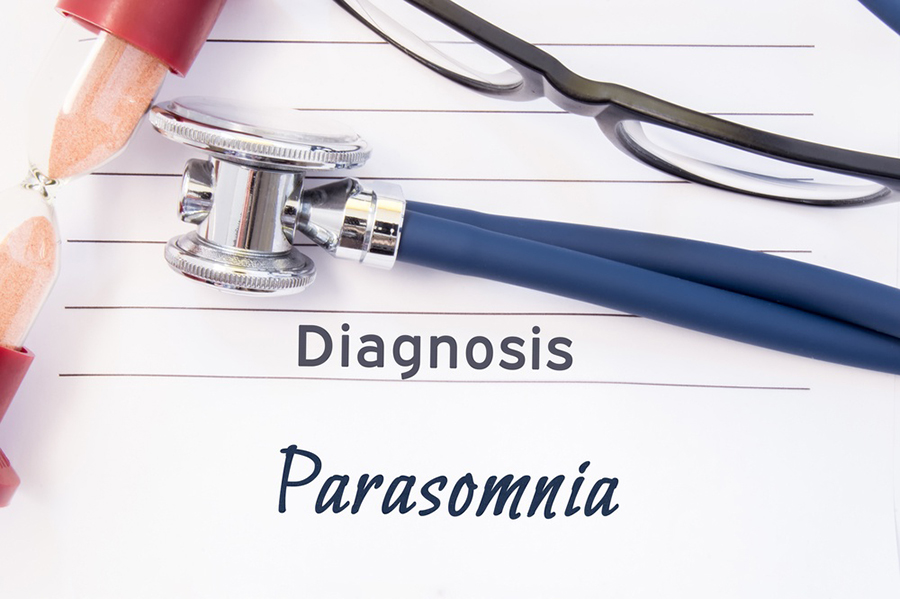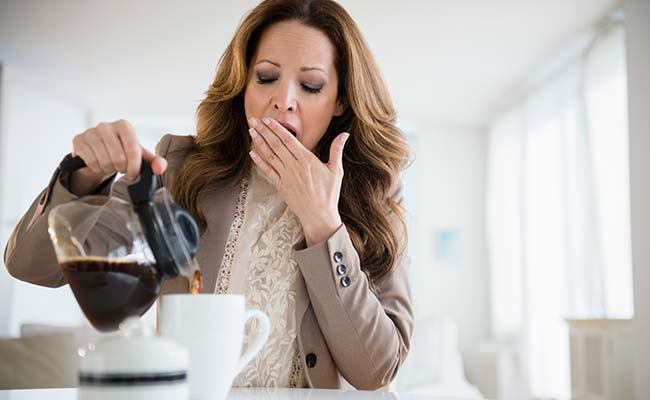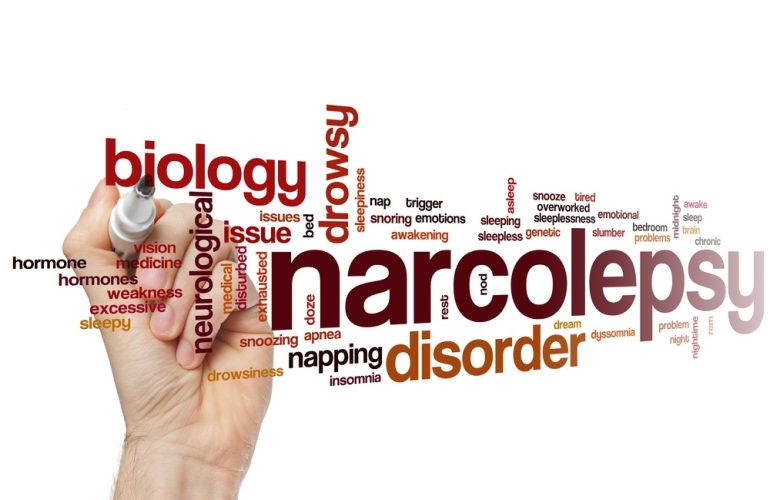If you have ever been told by friends or a bed partner that you talk or scream in your sleep, thrash around, kick your legs about, or sleepwalk, then you may have a sleep disorder called a parasomnia. Other outwardly visible symptoms and signs of parasomnia can include being confused when waking—for example, saying things that don’t make sense.
Other examples include night terrors (common in children), sleep paralysis, sleepwalking, sleep eating, or feeling like you’re being awakened by loud noises that no one else can hear.
Sometimes parasomnia behaviors can even include doing bizarre or dangerous things while you’re asleep, like gardening, eating coffee grounds from the trash, cooking on the stove in your kitchen, or trying to drive a car.
However, most of the time—fortunately—parasomnia is harmless.
What Exactly Is a Parasomnia?
The class of sleep disorders referred to as parasomnia is defined as any abnormal behavior that you engage in when you’re asleep, or when you’re on the edges of sleep—just waking up or drifting off.
The field of sleep medicine has categorized these behaviors broadly according to when they occur. You can be diagnosed with either a REM sleep parasomnia or a non-REM sleep parasomnia. That is to say, your abnormal sleep behaviors happen either during your REM (rapid eye movement) sleep or your non-REM sleep.
Parasomnias can be frightening, confusing, and annoying to the people who have them—and often, even more so to their bed partners. Loss of control of your body and the things you say (or scream) can be embarrassing and even scary, for you and for the people around you. However, most parasomnias are not serious and will not harm you.
However, it is possible for parasomnias to detract from your quality of life. The potential health problems that arise from having a parasomnia include disrupted sleep cycles (fragmented sleep) and occasional risky behavior.
The Health Risks of Having a Parasomnia
Having a parasomnia can lead to fragmented sleep, which means your sleep cycles are interrupted or even skipped altogether. You may partly or fully emerge from sleep at intervals throughout the night, and not stay in all the sleep stages long enough for your body to self-repair and consolidate memories. Studies show that a night of fragmented sleep can be equivalent to a night of no sleep at all.
If you experience parasomnias and sleep fragmentation night after night, this loss of good quality, restorative shuteye can add up over the long term, leading to all the same health issues that accompany chronic sleep deprivation: weight gain, an increased risk of cardiovascular disease, headaches, irritability, mood disorders, poor work and school performance, and even cognitive issues.
Sleep deprivation can also lead to more acute issues arising from excessive daytime sleepiness, such as motor vehicle accidents and workplace accidents.
The second kind of health risk that may result from having an undiagnosed parasomnia is the risk of self-harm or harm to others. While both issues are very rare, injuries and other health issues are possible. Examples:
- Self-harm: While sleeping, you may fall out of bed or down the stairs, twist an ankle, sustain a head injury, walk in the middle of the road, trip and fall, or try to drive a car with poor results. If you have a sleep eating parasomnia, you may eat an excessive amount of high-calorie food, leading to weight gain or heart disease. You may eat a combination of foods that inflame your stomach or consume a toxic item such as detergent, kitchen cleaner, garbage, or prescription medications.
- Harm to others: Though uncommon, it is possible that a parasomnia could lead you to inadvertently injure someone else. For example, if you kick or thrash around during sleep, you may punch or hit your bed partner. Driving a car while asleep can lead to a car accident.
Types of Parasomnias: An Overview
If you are here, you may have some sense that you have a sleep disorder. Perhaps you searched for “What is a parasomnia, and do I have one?” You may also wonder which type of parasomnia describes your sleep behavior.
Parasomnias are classified into two categories: Non-REM Related and REM Related.
Parasomnias: Non-REM Related
Non-REM related parasomnias occur during the non-REM stages of sleep (stages 1, 2, 3, or 4), and the behaviors usually manifest during the earlier part of your sleep. For most people, that means earlier in the night.
The most commonly reported parasomnias in this category are listed below.
- Confusional Arousals. A noise or a person arouses the sleeper from sleep, or appears to; after this point, all their seemingly “awake and alert” responses are confused or nonsensical because their thinking and memory functions are not working correctly. The sleeper may even have entire, weird conversations while asleep. Most do not recall their behavior when they’re told about it later.
- Night Terrors (sleep terrors). Usually occurring in the first half of the sleep session, this parasomnia involves sitting up or getting out of bed with eyes open. The sleeper looks and seems to be afraid: their heart races and they may gasp, shout, and thrash about in bed. If you have night terrors, you look scared, but in reality, you’re sleeping through this entire display unaware. Frequently, this parasomnia is more disturbing to family members than to the affected individual.
- Sleepwalking (somnambulism). Sleepwalkers get out of bed and move around with their eyes open and glazed. Frequently they will awaken in the wrong place, like another part of their home or outdoors. In this state, you’re asleep but capable of carrying out both simple and complex tasks like opening and closing doors or running a vacuum cleaner. Episodes can last seconds or minutes. As with confusional arousal, often the sleeper will have no memory of having gotten out of bed.
- Sleep Related Eating Disorder (SRED). Sometimes triggered by prescription sleep medications, this parasomnia can also happen independent of any outside cause. A person with SRED may get up while asleep and binge eat or drink, usually high-calorie foods like ice cream or potato chips. They may combine foods in strange and unappetizing ways, eat raw or frozen meats, or even try to cook. Episodes can last a few minutes. Most people don’t remember them later.
REM Sleep Related Parasomnias
These parasomnias happen during REM sleep in the later parts of the night.
- REM Sleep Behavior Disorder (RBD). RBD is a brain disorder that causes extremely vivid, active, and often violent dreams. The sleeper will often move around, acting out the actions they’re experiencing. RBD can escalate over time and may cause you to harm anyone who’s within striking distance of you during your dream.
- Sleep Paralysis. This parasomnia tends to happen when you’re either about to fall asleep or about to wake up. You’re awake and alert, but you can’t speak or move your head, legs, or arms. You may hallucinate, seeing or sensing someone malevolent in the room with you. Episodes last a few seconds to a few minutes. Often, they end if someone touches you.
- Nightmare Disorder. Frequent nightmares that awaken you regularly and scare you from going back to sleep may qualify as a parasomnia.
- Other Parasomnias. Other behaviors that qualify as REM-related parasomnias include bedwetting (enuresis), tooth grinding (bruxism), sleep talking, sleep sex, and exploding head syndrome (when you awaken due to hearing loud bangs or crashing sounds). All of these can be disorienting or even alarming to the people who suffer from them.
What Causes a Parasomnia?
Age and genetics can be a factor. Some parasomnias happen when we’re children, such as bedwetting and night terrors, but gradually disappear as we grow out of them.
Trauma and illness can also trigger parasomnia. Some health conditions related to the brain and nervous system, like Parkinson’s, may be linked to RBD. Stress and PTSD can also cause short-term or recurring instances of unusual sleep behaviors.
Alcohol and drug use can cause parasomnia or worsen existing symptoms.
Similarly, medications like prescribed sleeping pills (including Ambien) can precipitate parasomnia, including sleep walking, sleep eating, and sleep driving.
If you suspect you have a parasomnia that’s disrupting your sleep, the best thing you can do is to tell your doctor and get a referral to a sleep specialist for testing and evaluation.
The good news: You can improve your sleep. Many parasomnias can be treated and managed with a combination of lifestyle changes, behavioral therapy, and medication.
If you or a loved one suffers from what sounds like a parasomnia, we can help. Contact Sweet Sleep Studio today at (913) 221-6059 in the Kansas City Metro Area to schedule an appointment with Abid Bhat, MD.




